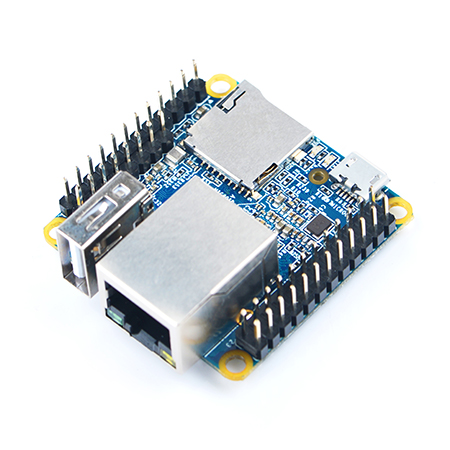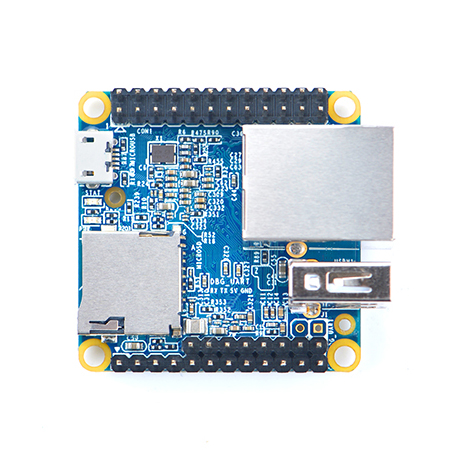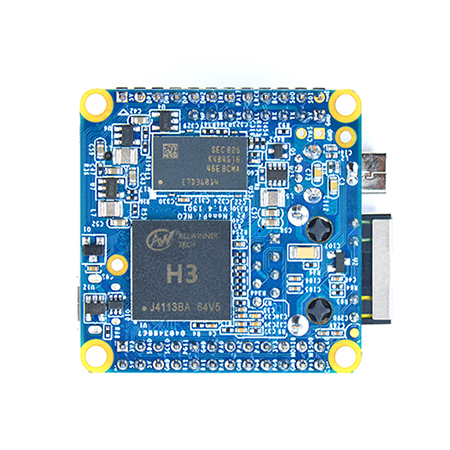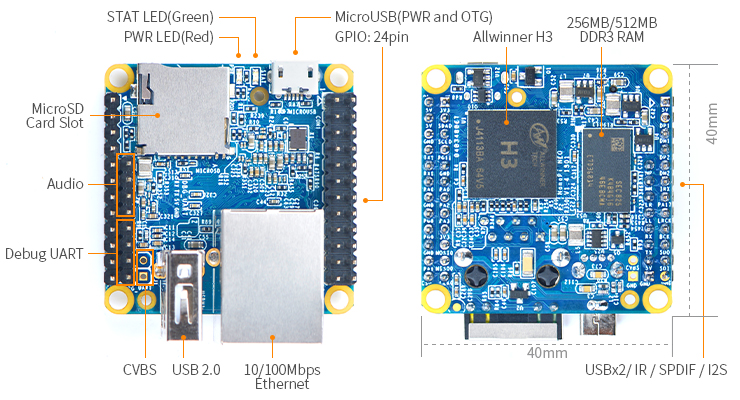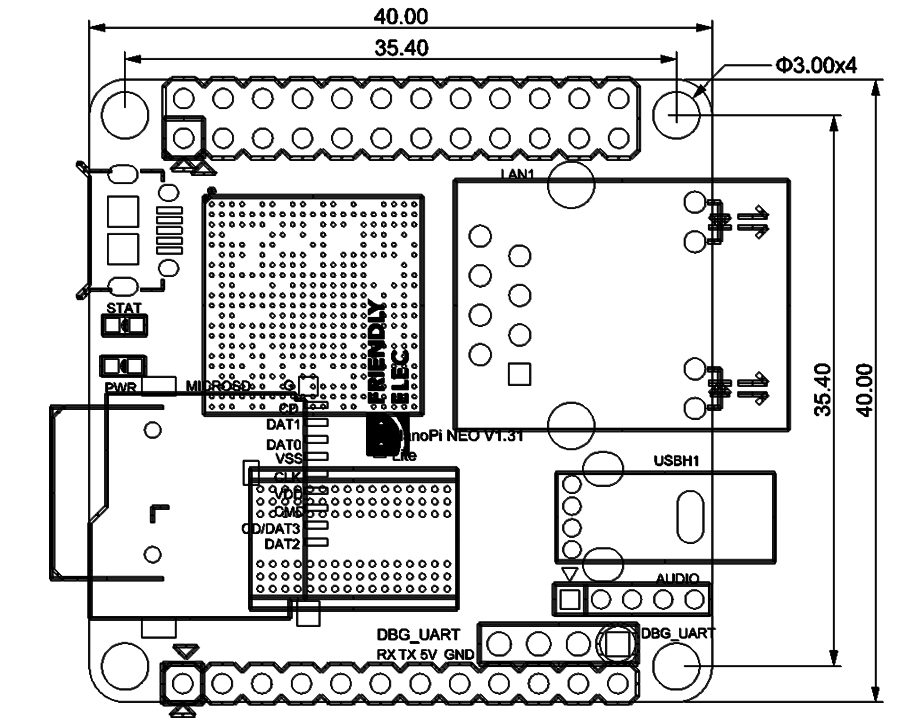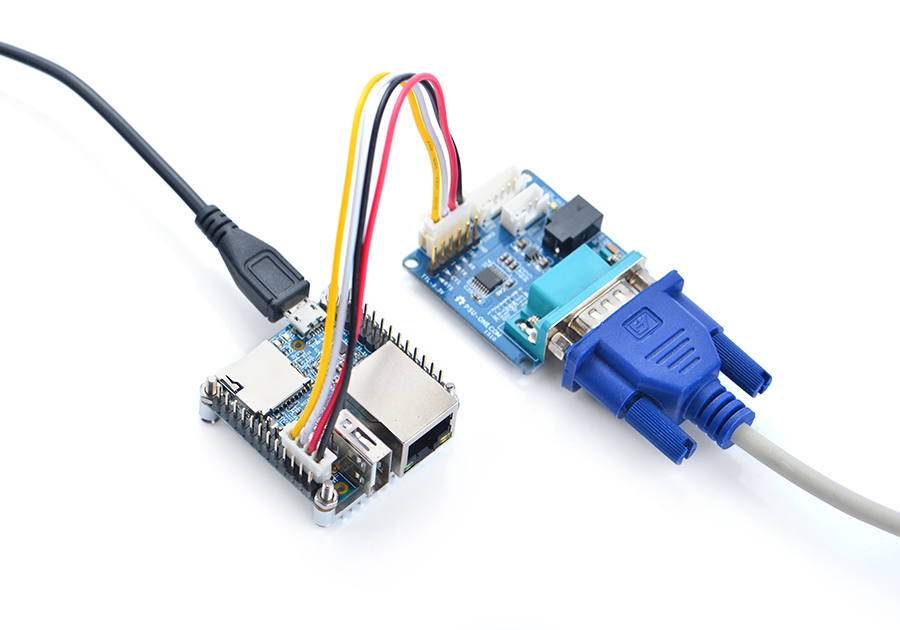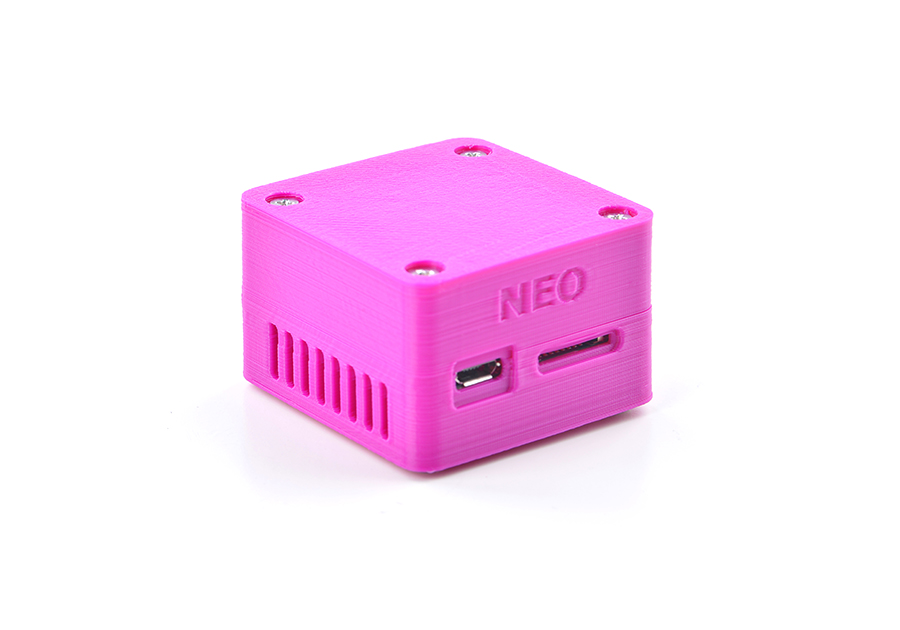Difference between revisions of "NanoPi NEO"
(→Check CPU's Working Temperature) |
(→Check CPU's Working Temperature) |
||
| Line 281: | Line 281: | ||
cpu_freq | cpu_freq | ||
</syntaxhighlight> | </syntaxhighlight> | ||
| + | |||
| + | ===Check System Information with Rpi-Monitor=== | ||
| + | Our Ubuntu-Core contains the Rpi-Monitor utility with which users can check system information and status.<br> | ||
| + | In our case our NEO's IP was 192.168.1.230 and we typed the following IP in a browser: | ||
| + | <syntaxhighlight lang="bash"> | ||
| + | 192.168.1.230:8888 | ||
| + | </syntaxhighlight> | ||
| + | We entered the following page:<br> | ||
| + | [[File:rpi-monitor.png|frameless|500px|rpi-monitor]] <br> | ||
| + | Users can easily check these system information and status. | ||
==Make Your Own OS== | ==Make Your Own OS== | ||
Revision as of 07:24, 20 December 2016
Contents
1 Introduction
- The NanoPi NEO(abbreviated as NEO) is another fun board developed by FriendlyARM for makers, hobbyists and fans.
2 Hardware Spec
- CPU: Allwinner H3, Quad-core Cortex-A7 Up to 1.2GHz
- DDR3 RAM: 256MB/512MB
- Connectivity: 10/100M Ethernet
- USB Host: Type-A x 1, 2.54 mm pin x 2
- MicroSD Slot x 1
- MicroUSB: OTG, for power input
- Debug Serial Port: 4Pin, 2.54 mm pitch pin header
- GPIO: 2.54mm pitch 36pin. It includes UART, SPI, I2C, IO etc
- PCB Dimension: 40 x 40 mm
- Power Supply: DC 5V/2A
- OS/Software: u-boot and UbuntuCore
3 Diagram, Layout and Dimension
3.1 Layout
- GPIO Pin Description
Pin# Name Linux gpio Pin# Name Linux gpio 1 SYS_3.3V 2 VDD_5V 3 I2C0_SDA 4 VDD_5V 5 I2C0_SCL 6 GND 7 GPIOG11 203 8 UART1_TX/GPIOG6 198 9 GND 10 UART1_RX/GPIOG7 199 11 UART2_TX/GPIOA0 0 12 PWM1/GPIOA6 6 13 UART2_RTS/GPIOA2 2 14 GND 15 UART2_CTS/GPIOA3 3 16 UART1_RTS/GPIOG8 200 17 SYS_3.3V 18 UART1_CTS/GPIOG9 201 19 SPI0_MOSI/GPIOC0 64 20 GND 21 SPI0_MISO/GPIOC1 65 22 UART2_RX/GPIOA1 1 23 SPI0_CLK/GPIOC2 66 24 SPI0_CS/GPIOC3 67
- USB/Audio/IR Pin Description
NanoPi-NEO NanoPi-NEO V1.1/V1.2 Pin# Name Description Pin# Name Description 1 VDD_5V 5V Power Out 1 VDD_5V 5V Power Out 2 USB-DP1 USB1 DP Signal 2 USB-DP1 USB1 DP Signal 3 USB-DM1 USB1 DM Signal 3 USB-DM1 USB1 DM Signal 4 USB-DP2 USB2 DP Signal 4 USB-DP2 USB2 DP Signal 5 USB-DM2 USB2 DM Signal 5 USB-DM2 USB2 DM Signal 6 GPIOL11/IR-RX GPIOL11 or IR Receive 6 GPIOL11/IR-RX GPIOL11 or IR Receive 7 SPDIF-OUT/GPIOA17 GPIOA17 or SPDIF-OUT 7 SPDIF-OUT/GPIOA17 GPIOA17 or SPDIF-OUT 8 MICIN1P Microphone Positive Input 8 PCM0_SYNC/I2S0_LRC I2S/PCM Sample Rate Clock/Sync 9 MICIN1N Microphone Negative Input 9 PCM0_CLK/I2S0_BCK I2S/PCM Sample Rate Clock 10 LINEOUTR LINE-OUT Right Channel Output 10 PCM0_DOUT/I2S0_SDOUT I2S/PCM Serial Data Output 11 LINEOUTL LINE-OUT Left Channel Output 11 PCM0_DIN/I2S0_SDIN I2S/PCM Serial Data Input 12 GND 0V 12 GND 0V
- V1.1/V1.2 Audio
Pin# Name Description 1 MICIN1P Microphone Positive Input 2 MICIN1N Microphone Negative Input 3 LINEOUTR LINE-OUT Right Channel Output 4 GND 0V 5 LINEOUTL LINE-OUT Left Channel Output
- Debug Port(UART0)
Pin# Name 1 GND 2 VDD_5V 3 UART_TXD0 4 UART_RXD0
- Note:
- SYS_3.3V: 3.3V power output
- VVDD_5V: 5V power input/output. When the external device’s power is greater than the MicroUSB's the external device is charging the board otherwise the board powers the external device. The input range is 4.7V ~ 5.6V
- All pins are 3.3V, output current is 5mA
- For more details refer to the document: NanoPi-NEO-1606-Schematic.pdf
3.2 Dimensional Diagram
- For more details refer to the document: pcb file in dxf format
4 Get Started
4.1 Essentials You Need
Before starting to use your NanoPi NEO get the following items ready
- NanoPi NEO
- microSD Card/TFCard: Class 10 or Above, minimum 8GB SDHC
- microUSB power. A 5V/2A power is a must
- A Host computer running Ubuntu 14.04 64 bit system
4.2 TF Cards We Tested
To make your NanoPi NEO boot and run fast we highly recommand you use a Class10 8GB SDHC TF card or a better one. The following cards are what we used in all our test cases presented here:
- SanDisk TF 8G Class10 Micro/SD TF card:
- SanDisk TF128G MicroSDXC TF 128G Class10 48MB/S:
- 川宇 8G C10 High Speed class10 micro SD card:
4.3 Make an Installation TF Card
4.3.1 Get Image Files
Visit this link download link to download image files and the flashing utility:
Image Files nanopi-neo-core-qte-sd4g.img.zip UbuntuCore with Qt-Embedded Image File Flash Utility: win32diskimager.rar Windows utility for flashing Debian image. Under Linux users can use "dd"
4.3.2 Make UbuntuCore with Qt Embedded Image Card
- Extract the nanopi-neo-core-qte-sd4g.img.zip and win32diskimager.rar files. Insert a TF card(at least 4G) into a Windows PC and run the win32diskimager utility as administrator. On the utility's main window select your TF card's drive, the wanted image file and click on "write" to start flashing the TF card.After flashing is done insert this TF card to your NanoPi NEO and connect the board to a 5V/2A power NEO will be automatically powered on. If the blue LED is flashing it indicates the system is being booted.
5 Work with Ubuntu-Core with Qt-Embedded
5.1 Run Ubuntu-Core with Qt-Embedded
- Insert a TF card with UbuntuCore image files into your NanoPi NEO, connect the board to a 5V/2A power source the board will be automatically powered on. If you can see the blue LED flashing it means your board is working and UbuntuCore is being loaded.
- If you want to do kernel development you need to use a serial communication board, ie a PSU-ONECOM board, which will allow you to operate the board via a serial terminal.
- Here is a setup where we connect a NanoPi NEO to a PC via the PSU-ONECOM and you can power on your NEO from either the PSU-ONECOM or the board's MicroUSB:
- It has two user names: root and fa and the password for both is "fa".
- Update packages
sudo apt-get update
5.2 Ethernet Connection
If the NanoPi NEO is connected to a network via Ethernet before it is powered on it will automatically obtain an IP after it is powered up. If it is not connected via Ethernet or its DHCP is not activated obtaining an IP will fail and system will hang on for about 15 to 60 seconds.In this case you can try obtaining an IP by using the following command
dhclient eth0
5.3 Login via SSH
The NanoPi NEO doesn't have a video output interface. You can log into the board via SSH. In our test the IP address detected by our router was 192.168.1.230 and we ran the following command to log into the NanoPi NEO:
ssh root@192.168.1.230
The password is fa。
5.4 Extend TF Card's Section
We strongly recommend you to do this right after you have made an installation TF card since this will greatly enhance your NEO's experience
- Solution 1: Extend your card's rootfs section under a host PC:
sudo umount /dev/sdx? sudo parted /dev/sdx unit % resizepart 2 100 unit MB print sudo resize2fs -f /dev/sdx2
Note: you need to replace "/dev/sdx" with the device name in your system.
- Solution 2: Extend your card's rootfs section under NEO running UbuntuCore:
sudo fs_resizeFollowing the prompt type in "y" to start re-sizing the file system and a second "y" to reboot the NEO. After the NEO is rebooted check the new section by using the following command:
df -h
5.5 Connect USB WiFi to NEO
Our system has support for popular USB WiFi drivers. Many USB WiFi modules are plug and play with our system. Here is a list of models we tested;
Number Model 1 RTL8188CUS/8188EU 802.11n WLAN Adapter 2 RT2070 Wireless Adapter 3 RT2870/RT3070 Wireless Adapter 4 RTL8192CU Wireless Adapter 5 MI WiFi mt7601
If you NanoPi NEO is connected to a USB WiFi and is powered up you can log into NEO and run the following command to check if the USB WiFi is recognized. If "wlan0" is listed it indicates your USB WiFi has been recognized:
ifconfig -a
Open the /etc/wpa_supplicant/wpa_supplicant.conf file and append the following lines:
network={ ssid="YourWiFiESSID" psk="YourWiFiPassword" }
The "YourWiFiESSID" and "YourWiFiPassword" need to be replaced with your actual ESSID and password.
Save, exit and run the following commands to connect to your WiFi router:
ifdown wlan0 ifup wlan0
If your WiFi password has special characters or you don't want your password saved as plain text you can use "wpa_passphrase" to generate a psk for your WiFi password. Here is how you can do it:
wpa_passphrase YourWiFiESSID
Following the prompt type in your password and you will get a new password in the /etc/wpa_supplicant/wpa_supplicant.conf file. Now you can replace the existing password in the wlan0 file with the new one.
5.6 Connect NanoPi NEO to USB Camera(FA-CAM202)
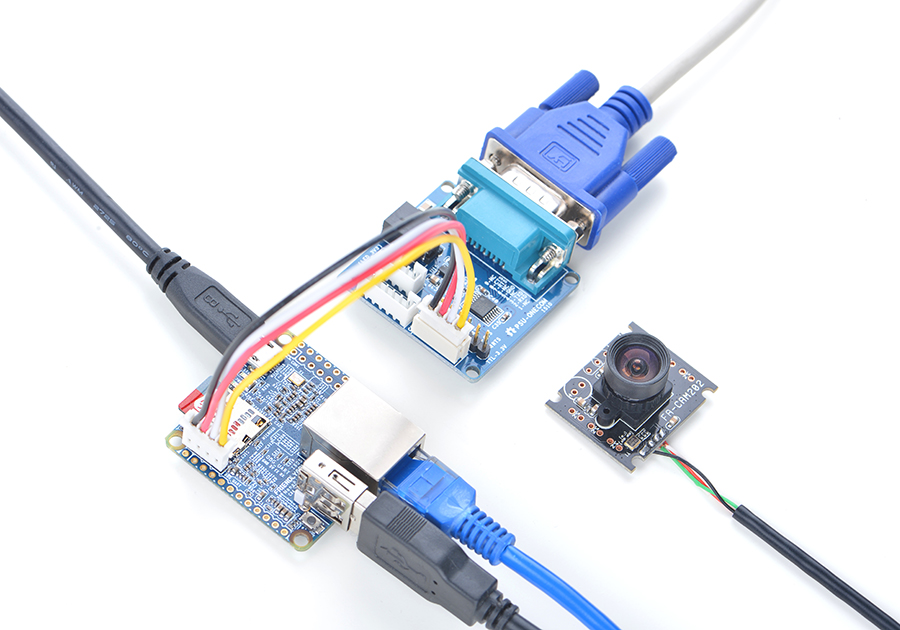
The FA-CAM202 is a 2M-pixel USB camera module.
Boot your NEO, connect NEO to the internet, log in the system as root, compile and run the mjpg-streamer utility:
cd /root/mjpg-streamer make ./start.sh
The mjpg-streamer is an open source media server. After it is started successfully you will see the following messages:
i: Using V4L2 device.: /dev/video0 i: Desired Resolution: 1280 x 720 i: Frames Per Second.: 30 i: Format............: YUV i: JPEG Quality......: 90 o: www-folder-path...: ./www/ o: HTTP TCP port.....: 8080 o: username:password.: disabled o: commands..........: enabled
In our case our NEO's IP address was 192.168.1.123. We typed "192.168.1.123:8080" on a browser, entered and we got the following screenshot:

The mjpg-streamer uses libjpeg to soft-encode camera's input data. You can use ffmpeg to hard-encode data which greatly increases system's efficiency:
ffmpeg -t 30 -f v4l2 -channel 0 -video_size 1280x720 -i /dev/video0 -pix_fmt nv12 -r 30 -b:v 64k -c:v cedrus264 test.mp4
By default it records a 30-second video. When you type "q" it will stop recording and the recorded video will be saved as a test.mp4 file.
5.7 Check CPU's Working Temperature
Open a terminal on your NanoPi NEO and you can type the following command to read H3's temperature and frequency:
cpu_freq
5.8 Check System Information with Rpi-Monitor
Our Ubuntu-Core contains the Rpi-Monitor utility with which users can check system information and status.
In our case our NEO's IP was 192.168.1.230 and we typed the following IP in a browser:
192.168.1.230:8888We entered the following page:
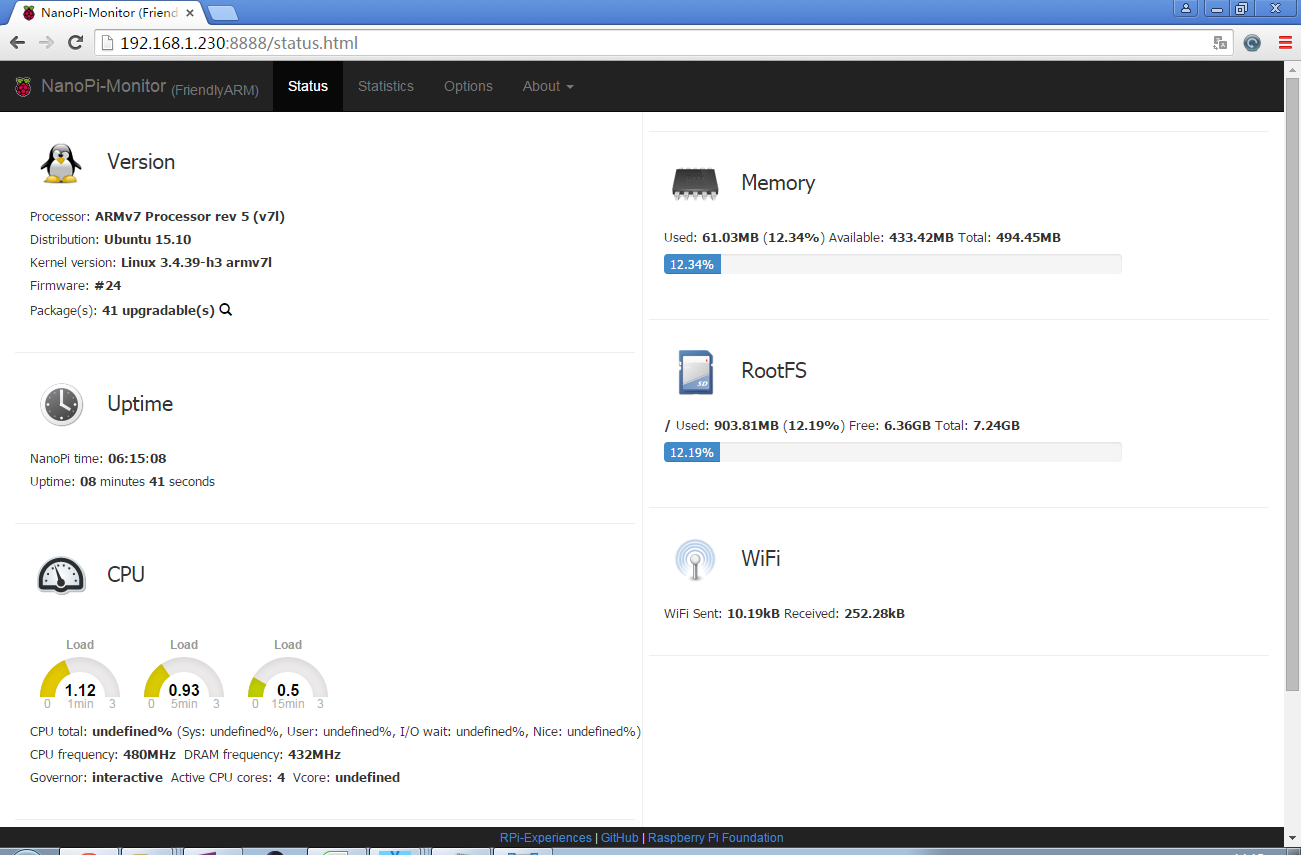
Users can easily check these system information and status.
6 Make Your Own OS
Visit download link and go to the sources directory and download nanopi-H3-bsp.
Use the 7-zip utility to uncompress it and a lihee directory and an Android directory will be generated. Or you can get it from our github:
git clone https://github.com/friendlyarm/h3_lichee.git lichee
Note: "lichee" is the project name named by Allwinner for its CPU's source code which contains the source code of U-boot, Linux kernel and various scripts.
6.1 Compile lichee Source Code
Compilation of the H3's BSP source code must be done under a PC running a 64-bit Linux.The following cases were tested on Ubuntu-14.04 LTS-64bit:
sudo apt-get install gawk git gnupg flex bison gperf build-essential \ zip curl libc6-dev libncurses5-dev:i386 x11proto-core-dev \ libx11-dev:i386 libreadline6-dev:i386 libgl1-mesa-glx:i386 \ libgl1-mesa-dev g++-multilib mingw32 tofrodos \ python-markdown libxml2-utils xsltproc zlib1g-dev:i386 u-boot-tools
Enter the lichee directory and un the following command to compile the whole package:
cd lichee ./build.sh -p sun8iw7p1 -b nanopi-h3
After this compilation succeeds a u-boot, Linux kernel and kernel modules will be generated.
Note: the lichee directory contains a cross-compiler we have setup. When the build.sh script runs it will automatically call this cross-compiler.
6.2 Package System Modules
./gen_script.sh -b nanopi-neo
This command copies the generated executables including u-boot and Linux kernel and configuration files to the "lichee/tools/pack/out/" directory and generates a script.bin file.
The script.bin file is designed by Allwinner for its CPUs. For more details refer to script.bin.
6.3 Compile U-boot
./build.sh -p sun8iw7p1 -b nanopi-h3 -m uboot
After a u-boot executable is generated some extra patches need to be patched to it. Run "./build.sh pack" to patch this executable.
If you want to manually patch the executable refer to H3_Manual_build_howto and run the following commands to update the u-boot in the TF card:
./fuse_uboot.sh /dev/sdx
Note: you need to replace "/dev/sdx" with the device name in your system.
6.4 Compile Linux Kernel
If you want to compile the Linux kernel run the following command:
./build.sh -p sun8iw7p1 -b nanopi-h3 -m kernel
After the compilation is done a uImage and its kernel modules will be generated under "linux-3.4/output".
6.5 Clean Source Code
./build.sh -p sun8iw7p1_linux -b nanopi-h3 -m clean
7 3D Printing Files
8 Other OS Support
8.1 Armbian
home page: http://www.armbian.com/nanopi-neo/
8.2 FreeBSD
Thanks to Ganbold Tsagaankhuu FreeBSD runs on NEO. He has created FreeBSD 12.0-CURRENT image and it can be downloaded from: https://www.mediafire.com/folder/bfbs771c3ajar/FreeBSD
9 Resources
- Schematics
- Dimensional Diagram
- H3 Datesheet Allwinner_H3_Datasheet_V1.2.pdf
- Matrix Modules & Wiki Sites:
- Button
- LED
- A/D Converter
- Relay
- 3-Axis Digital Accelerometer
- 3-Axis Digital Compass
- Temperature Sensor
- Temperature & Humidity Sensor
- Buzzer
- Joystick
- I2C(PCF8574)+LCD1602
- Sound Sensor
- Ultrasonic Ranger
- GPS
- Matrix - Compact Kit
- Fire Sensor
- CAM500A Camera
- BAll Rolling Switch
- 2'8 SPI Key TFT 2.8" SPI LCD
- IR Counter
- IR Receiver
- L298N Motor Driver
- MQ-2 Gas Sensor
- MQ-3 Gas Sensor
- One_Touch_Sensor
- _Photoresistor
- _Potentiometer
- Pressure & Temperature Sensor
- RGB LED
- RTC
- Rotary Encoder
- Soil Moisture Sensor
- Thermistor
- USB WiFi
- Water Sensor
10 Update Log
10.1 July-07-2016
- Released English Version
10.2 August-09-2016
- Added Other OS Support
10.3 Sep-08-2016
- Added Section 7
- Updated sections 5.3, 5.5 and 9
10.4 Nov-03-2016
- Added Section 5.6
